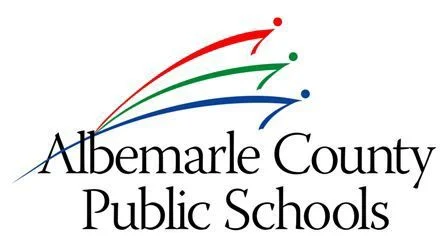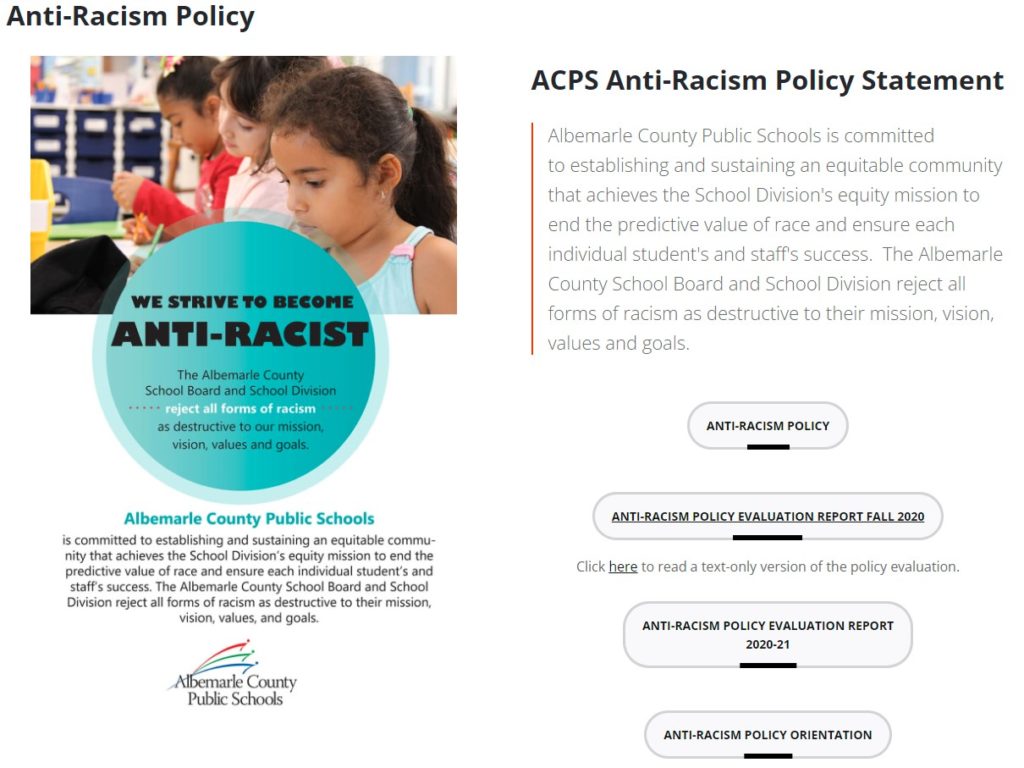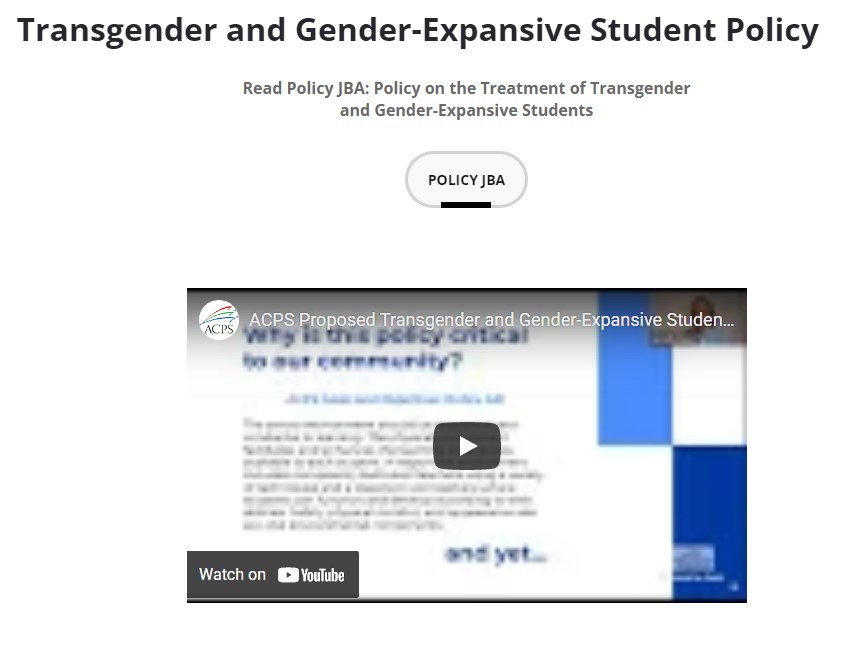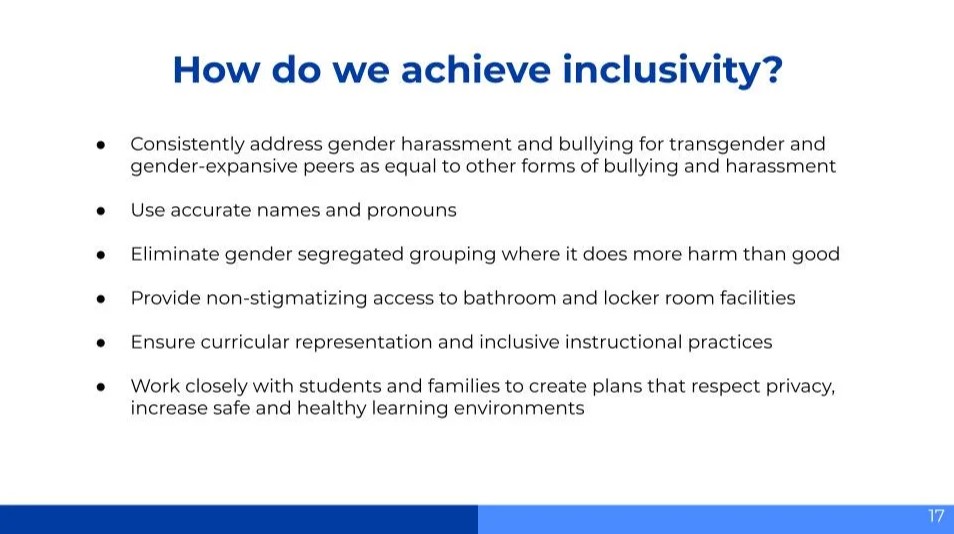
Albemarle County Public Schools assistant superintendent appears to tell staff to quit if they disagree with district’s “Anti-Racism Policy”; middle school principal hosts training session for faculty with presenter encouraging adults to allow toddlers to “explore” their gender identity
Incidents
Albemarle County Public Schools has a page on the school district’s website titled “Anti-Racism Policy” that features the district’s policy on the issue of racial equity. The policy is simply titled “Anti-Racism.” The school district states in the policy that “personal and institutional racism have historically existed and continues to exist in the Division.” The school district continues to state that “combating racism in our schools is a legal and moral imperative.” The district further explains:
However, racial inequities were created over time and can be eliminated. Similarly, personal prejudice is learned and can be unlearned. Educators play a vital role in reducing racism and inequity by recognizing the manifestations of racism, creating culturally inclusive learning and working environments, and dismantling educational systems that directly or indirectly perpetuate racism and privilege through teaching, policy, and practice.
The policy mandates that “each school shall post a public statement against racism in a location visible to students, staff, and visitors entering the school.” The statement must say: “Albemarle County Public Schools is committed to establishing and sustaining an equitable community that achieves the School Division’s equity mission to end the predictive value of race and ensure each individual student’s and staff’s success. The Albemarle County School Board and School Division reject all forms of racism as destructive to their mission, vision, values, and goals.”
The policy also states that students in the school district will be used to help implement equity. The policy explains that “the Board shall establish an organization or committee of students in the Division to promote equity and diversity and to serve as leaders and spokespersons within their schools and the Division.”
The policy further explains that the school district will adopt “restorative justice” practices to “reduce racial disparities in discipline and suspension.” This includes “when school administrators determine a student has committed a racist act, the student will be provided the opportunity to learn about the impact of their actions on others through such practices as restorative justice, mediation, role play or other explicit policies or training resources.”
The policy then explains how the school district will change the curriculum taught to students in an effort to implement racial equity. The policy lists the following plans:
- Curriculum and instructional materials for all grades shall reflect cultural and racial diversity and include a range of perspectives and experiences, particularly those of historically underrepresented groups of color.
- All curriculum materials shall be examined for racial bias by the Division’s Department of Student Learning. Where materials reflect racial bias, teachers utilizing the materials will acknowledge the bias and communicate it to students and parents.
- The Board and Division shall implement an anti-racist curriculum and provide educational resources for students at every grade level.
- Student in-class and extra-curricular programs and activities shall be designed to provide opportunities for cross-cultural and cross-racial interactions to foster respect for cultural and racial diversity. The Board shall support interschool activities that will allow students to experience the diversity within the Division.
The policy states that all of the school district’s staff will be trained in “anti-racism” and in how “racism produces inequitable practices and outcomes.” The policy states that “all teachers and administrators shall be trained in cultural awareness and/or culturally responsive teaching practices” and that “culturally responsive teaching practices shall be incorporated into Board approved appraisal systems, including the teacher appraisal system and the administrator performance appraisal.” The phrase “culturally responsive teaching” is often used to describe a method of teaching that includes the race and ethnicity of students as part of the lessons taught in classrooms. The school district will also “ensure there are various, including anonymous, means for students and staff to report racism and other forms of discrimination.”

The school district also has a document titled “Am I an Anti-Racist?” The document is intended to provide “faculty and staff with the tools they need to understand and interrupt systemic racism.” The document encourages staff to be an “anti-racist” and states that “an Anti-Racist is someone who practices identifying, challenging, and changing the values, structures, and behaviors that perpetuate systemic racism.” The document then lists four attributes of being anti-racist:
- Self-Aware: Able to recognize one’s own privilege and name examples of racism.
- An Upstander: Challenges and disrupts practices that perpetuate racism and maintain power.
- A Lifelong Learner: Actively seeks new information and opportunities to grow in one’s understanding about race and racism.
- Collaborate: Works with others to learn about multiple perspectives build more equitable structures and practices.
The document also states that “anti-racist teaching confronts prejudice through practices such as the discussion of past and present racism, stereotyping, and discrimination in society.” The document then lists perceived “anti-racism definitions.” A few examples listed are:
- Colorism – favoritism toward light-skinned people of color
- Eurocentric – a perspective centered on a Western worldview that has become intrinsic to the American cultural identity
- Heterosexism – a system of advantage based on sexual orientation
- Internalized Oppression – internalized belief of racial inferiority about own racial group
- Internalized Sexism – internalized belief of gender inferiority based on gender
- Passing – an attempt by non-whites with light-skinned privilege to skirt the discrimination barriers imposed by law and custom by attempting to “pass” for white
- White Privilege – an unacknowledged system of favoritism and advantage granted to white people as the beneficiaries of historical conquest
- White Supremacy – a system of exploitation to maintain wealth, power, and white privilege
The school district’s “Anti-Racism Policy” page also has a video featuring Assistant Superintendent Bernard Hairston. He appeared angry in the video and stated that he has “experienced racism” in the school district. [Time Stamp: 0:30] He also stated that the School Board “must be serious about confronting this institutional system built on advancing whiteness” due to hiring him. [Time Stamp: 0:55] He then appeared to target his “white colleagues” and even some “colleagues of color”:
From my white colleagues who are bus drivers to principals, this work is about acknowledging that you don’t know what you don’t know about race. You are often invisible because you can be. To my colleagues of color who are office associates to teachers, it is about how you advance and respect the learning curves of different points of view about race simply by pushing just hard enough but not so hard you close doors. Now ask yourself: To what degree does race complicate your life if you’re white versus a person of color? This work is about all of us acknowledging our part as change agents. [Time Stamp: 1:35]
The assistant superintendent then appeared to attack his “white colleagues” when discussing achievement gaps. He stated while yelling:
Now not too long ago, I was engaged in a conversation with a group of my white colleagues about achievement gaps between students of color and white students. The low level in which I perceived their concern angered me to the core of my soul, resulting in this statement: “If these were your children, your relatives, people who look like you, the urgency for addressing these longstanding inequitable practices and downright embarrassing results would be different.” There was silence, little to no eye contact. But what is most concerning is that no one in that group has spoken to me about that exchange. [Time Stamp: 3:30]
The assistant superintendent then appeared to tell the school district’s employees who disagreed with him to quit. He stated while once again yelling:
Now consider this controversial statement by some researchers: “You are either a racist or an anti-racist.” It is time for you to think about how you will own this required anti-racism training and the policy. I leave you with this thought. Be real my colleagues and ask yourself if you are on this moving Albemarle County Public School anti-racism school bus or if you need help finding your seat and keeping your seat or if it’s time for you to just get off the bus. [Time Stamp: 5:00]
The school district’s website also has a page titled “Transgender and Gender-Expansive Student Policy” that features the district’s policy on the issue of transgender students. The policy is titled the “Policy on the Treatment of Transgender and Gender-Expansive Students.” The school district states in the policy that “schools must be proactive in creating a culture that respects and values all students and fosters understanding of gender identity and expression within the school community.” The school district also states goals in the policy that include to “support students so that they may participate in all aspects of school life consistent with their gender identity” and to “provide consistent support and training to ACPS administration and staff to enable them to address matters of student gender identity and expression in a consistent and appropriate manner.”
The school district’s policy appears to state that a student’s “gender identity” may be kept a secret from parents. The policy states:
In some cases, gender-expansive students may not want their parents to know about their gender-expansive or transitioning status. These situations must be addressed on a case-by-case basis and will require schools to balance the goal of supporting the student with the requirement that parents be kept informed about their children. The most important consideration in such situations is the physical and mental health and safety of the student.
The policy then appears to support young students having “medical treatments” and “surgeries” to transition to another gender. The policy states:
Some gender-expansive youth who are close to reaching puberty, or after starting puberty, may have medical treatments to reinforce their social transition. These treatments may include hormone suppressants, cross-gender hormone therapy, and, for a small number of young people, a range of gender-affirming surgeries. An individual’s decision about whether and how to undergo gender transition is personal and it will depend on their unique circumstances.
The policy also explains that the school district will work with students to help them transition. The school district even appears willing to help students transition without their parents knowing and encourages teachers to call Child Protective Services on parents in some scenarios. The policy lists the following steps the school district will take to help students in their transitioning process:
- In collaboration with the student and the student’s family (if the family is supportive of the student), develop a plan to ensure that the student has equal access and opportunity to participate in all programs and activities at school and is otherwise protected from gender-based discrimination at school.
- Discuss the school’s role in supporting the student’s transition.
- Identify school staff members who will be the key contact for the student and delineate their responsibilities in this regard.
- Make resources available to parents who have questions or concerns.
- Work with the family to prepare for a formal gender transition at school.
- Develop and implement measures for supporting the student and creating a sensitive supportive environment at school. These measures shall address preferred name and pronouns; physical education and intramural sports; bathrooms; locker rooms; safe spaces and zones and other safety supports; class trips and other school activities; and formal events, such as graduation. At the student’s request, the plan may be written, in which case, it shall be retained in a secure location apart of the student’s official school file. Despite these safeguards to preserve student confidentiality, the school should advise a minor student that it may be required by law to provide the written plan to parents under certain circumstances.
- If school administrators or teachers suspect or become aware that a student is being harmed, abused, or at risk of harm or abuse at home, they should report these concerns to Child Protective Services immediately.
The policy then reiterates that a student’s change in gender identity can be kept a secret from parents. The policy states that “some gender-expansive students have not talked to their parents about their gender identity and/or do not want their parents to know about their gender-expansive status based on safety concerns or fear about a lack of acceptance.” The policy continues to explain that “if the student does not want the school to contact the student’s parents, the school shall honor that request for privacy with the proviso that an underage student shall be advised that the school may not be able to implement certain aspects of the student’s transitioning plan without parental approval.”
The policy states that “every student is entitled to be addressed by the name and pronoun that corresponds to the student’s gender identity that is consistently asserted at school.” Teachers and school staff must also “honor a student’s request to be referred to by the name and gender that corresponds to their gender identity.” The policy further explains that “in those records which are not permanent pupil personnel records (such as guidance logs, anecdotal records, yearbooks, graduation programs), schools shall use the name and gender that is preferred and consistently asserted by the student at school.”
The policy also states that “students must be permitted to participate in physical education and intramural sports in accordance with the student’s gender identity that is consistently asserted at school.” The policy then explains that “gender-expansive students shall be provided access to facilities (restrooms, locker rooms or changing rooms) consistent with their gender identity consistently asserted at school.” The policy continues to explain that “a student whose gender identity is fluid should work
with their school to facilitate restroom and locker room access that affirms their identity.” Students who are uncomfortable with this are also mentioned: “Although some students may feel uncomfortable with a gender-expansive student using the same sex-specific facility, that discomfort is not a reason to deny access to the gender-expansive student.”
The school district will also provide training to school staff in dealing with transgender students in a positive manner. The policy will also be “incorporated into training for new school employees.” The policy then lists what the training for school staff will include:
- Terms, concepts, and current developmental understandings of gender identity, gender expression, and gender diversity in children and adolescents.
- Developmentally appropriate strategies for communication with students and parents about issues related to gender identity and gender expression that protect student privacy.
- Developmentally appropriate strategies for preventing and intervening in bullying incidents, including cyberbullying.
- Federal and state laws and ACPS policies relating to the rights of all students to a safe educational environment and right to privacy and responsibilities of staff in this regard.
- School planning guide for gender-expansive students.
- Equal access to facilities and activities that are consistent with a student’s gender identity.
- Classroom-management practices, curriculum, and resources that educators can integrate into their classrooms to help foster a more gender-inclusive environment for all students.
- Medical and physical considerations of safe transitioning for students, including adherence to a treatment plan provided by the student’s medical professional to the extent consistent with the skills and experience of the school’s health staff.

The school district’s transgender page has an alleged quote from an 11-year-old student who appears to identify as “non-binary.” The student states:
Being non-binary, this policy will make me feel safer and free to express myself at school. This policy will offer me support and help teachers understand how to make their classrooms more accepting of all kids. I don’t understand why some people don’t want me to feel safe and secure. I have as much of a right to learn at school as anyone else.

The school district also states that it intends to change the curriculum and “instructional practices” to include “representation” of transgender people. The district also reiterates that school staff will “use accurate names and pronouns.”

The school district explains that all school staff must follow the district’s transgender policy. The district states: “This policy and all other Albemarle County School Board policies, once approved, are binding for all ACPS employees. As of right now in the Commonwealth of Virginia, there has not been established any legal exemption related to this policy.”

On March 14, 2022, the Schilling Show reported on a transgender policy presentation that Mountain View Elementary School Principal Cyndi Wells provided to her faculty. The presentation was delivered on March 4, 2022. In the presentation, the principal apologized for misgendering another host of the presentation by using the wrong pronouns. This presenter specifically wanted to use the pronoun “they,” despite just being one person. [Time Stamp: 0:35]
The presentation featured an “Identity Spectrum” that attempted to show that gender is not binary. The slide in the presentation stated: “Non-binary = Refers to individuals who do not identify as man or a woman. There are many different terms used by non-binary people to describe their identity.” [Time Stamp: 1:40] This host who wants to use the pronoun “they” then discussed how people may choose to change their gender throughout the day:
You might see use to start the day saying, “Hey, my pronouns are he/him.” By the end of the day, I’m feeling more feminine so “she/her” or maybe I’m feeling like I’m a combination of both, and I’m sort of creating my own experience. [Time Stamp: 2:05]
This host then discussed using “binders” and “breast implants” on children in middle school. The host explained that chest binders are “really, really intense sports bras where they just flatten breast tissue to create the illusion of a more masculine chest.” The host then described breast implants as “foam inserts” that can fit into bras “to create the illusion of a more fuller chest.” [Time Stamp: 3:25]
This host then described teaching young children about pronouns by using a “pronoun game.” [Time Stamp: 4:25] The host also promoted allowing a young boy to wear “princess dresses.” The host explained: “Can I give this child space to just exist and present in this way. And it’s like, yes, you are Elsa. Let’s sing Frozen and dance it out.” [Time Stamp: 4:50]
The presenter then discussed how young is actually too young for children to learn about gender. The host provided a slide in the presentation that stated “Let Kids Explore.” The slide also stated that “children understand their own gender identity as young as 3-4 years of age.” [Time Stamp: 6:05] The host explained: “If you are working with tiny humans, Right? Like at the elementary level. What this is going to look like is exploration, is play, is I’m using language and names and different things like that to try to communicate.” [Time Stamp: 6:15]
The principal then discussed dealing with transgender students and their parents. She stated that the school deals with students and their gender identities on a case by case basis, but parents are not told until their children are ready for them know. She explained:
And so the first conversation is case by case. It’s talking with the child in class. It’s talking with us. It’s talking with the counselors. And then we’ll talk about that on a case by case basis. But the policy is very clear that, you know, we honor pronouns, names, that fluidity in school, and involve the families when the child is ready when we have that conversation. [Time Stamp: 7:30]
The host who preferred the pronoun “they” stated in the presentation that “gender is literally being reconstructed in real time.” The host also had a slide in the presentation at this time that stated: “1 in 10 elementary students said they do not conform to traditional gender norms.” [Time Stamp: 10:10]
A teacher then discussed that she has a student in her kindergarten class who at one point self-identified as “half boy, half girl.” The teacher then discussed not knowing what pronouns to use for this student. The host told the teacher to ask this kindergarten student what name and pronouns to use in class. [Time Stamp: 10:30]
Stay Informed

